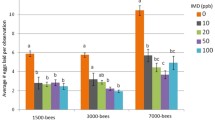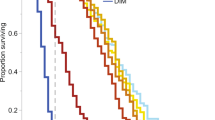Abstract
Honey bees provide important pollination services to crops and wild plants. The agricultural use of systemic insecticides, such as neonicotinoids, may harm bees through their presence in pollen and nectar, which bees consume. Many studies have tested the effects on honey bees of imidacloprid, a neonicotinoid, but a clear picture of the risk it poses to bees has not previously emerged, because investigations are methodologically varied and inconsistent in outcome. In a meta-analysis of fourteen published studies of the effects of imidacloprid on honey bees under laboratory and semi-field conditions that comprised measurements on 7073 adult individuals and 36 colonies, fitted dose–response relationships estimate that trace dietary imidacloprid at field-realistic levels in nectar will have no lethal effects, but will reduce expected performance in honey bees by between 6 and 20%. Statistical power analysis showed that published field trials that have reported no effects on honey bees from neonicotinoids were incapable of detecting these predicted sublethal effects with conventionally accepted levels of certainty. These findings raise renewed concern about the impact on honey bees of dietary imidacloprid, but because questions remain over the environmental relevance of predominantly laboratory-based results, I identify targets for research and provide procedural recommendations for future studies.


Similar content being viewed by others
References
Alghamdi A, Dalton L, Phillis A, Rosato E, Mallon EB (2008) Immune response impairs learning in free-flying bumble-bees. Biol Lett 4:479–481
Aupinel P, Fortini D, Michaud B, Marolleau F, Tasei JN, Odoux JF (2007) Toxicity of dimethoate and fenoxycarb to honey bee brood (Apis mellifera), using a new in vitro standardized feeding method. Pest Manag Sci 63:1090–1094
Bailey J, Scott-Dupree C, Harris R, Tolman J, Harris B (2005) Contact and oral toxicity to honey bees (Apis mellifera) of agents registered for use for sweet corn insect control in Ontario, Canada. Apidologie 36:623–633
Bonmatin JM, Moineau I, Charvet R, Fleche C, Colin ME, Bengsch ER (2003) A LC/APCI-MS/MS method for analysis of imidacloprid in soils, in plants, and in pollens. Anal Chem 75:2027–2033
Bonmatin JM, Marchand PA, Charvet R, Moineau I, Bengsch ER, Colin ME (2005) Quantification of imidacloprid uptake in maize crops. J Agric Food Chem 53:5336–5341
Bortolotti L, Montanari R, Marcelino J, Medrzycki P, Maini S, Porrini C (2003) Effects of sub-lethal imidacloprid doses on the homing rate and foraging activity of honey bees. Bull Insectol 56:63–67
BVL (2010) Bundesamt für Verbraucherschutz und Lebensmittelsicherheit. http://www.bvl.bund.de/cln_007/nn_496790/sid_DC14916176B10F16C97BA780A40B2F2B/EN/08__PresseInfothek__engl/01__Presse__und__Hintergrundinformationen/2009__02__09__pi__Maissaatgut__Mesurol__en.html__nnn=true. Accessed 12 July 2010
Colin ME, Bonmatin JM, Moineau I, Gaimon C, Brun S, Vermandere JP (2004) A method to quantify and analyze the foraging activity of honey bees: relevance to the sublethal effects induced by systemic insecticides. Arch Environ Contam Toxicol 47:387–395
Crawley M (2007) The R book. Wiley, Chichester
Cresswell JE (1999) The influence of nectar and pollen availability on pollen transfer by individual flowers of oil-seed rape (Brassica napus) when pollinated by bumblebees (Bombus lapidarius). J Ecol 87:670–677
Croft B (1990) Arthropod biological control agents and pesticides. Wiley, New York
Cutler GC, Scott-Dupree CD (2007) Exposure to clothianidin seed-treated canola has no long-term impact on honey bees. J Econ Entomol 100:765–772
de Jong FMW, de Snoo GR, van de Zande JC (2008) Estimated nationwide effects of pesticide spray drift on terrestrial habitats in the Netherlands. J Environ Manag 86:721–730
Decourtye A, Lacassie E, Pham-Delegue MH (2003) Learning performances of honeybees (Apis mellifera L) are differentially affected by imidacloprid according to the season. Pest Manag Sci 59:269–278
Decourtye A et al (2004a) Imidacloprid impairs memory and brain metabolism in the honeybee (Apis mellifera L.). Pestic Biochem Physiol 78:83–92
Decourtye A, Devillers J, Cluzeau S, Charreton M, Pham-Delegue MH (2004b) Effects of imidacloprid and deltamethrin on associative learning in honeybees under semi-field and laboratory conditions. Ecotoxicol Environ Saf 57:410–419
DEFRA (2007) Assessment of the risk posed to honeybees by systemic pesticides (Project no. PS2322). Department for Environment, Food and Rural Affairs, London
DEFRA (2009) Agriculture in the United Kingdom 2009. Department of Food, Environment and Rural Affairs, London
Desneux N, Decourtye A, Delpuech JM (2007) The sublethal effects of pesticides on beneficial arthropods. Annu Rev Entomol 52:81–106
El Hassani AK, Dacher M, Gary V, Lambin M, Gauthier M, Armengaud C (2008) Effects of sublethal doses of acetamiprid and thiamethoxam on the behavior of the honeybee (Apis mellifera). Arch Environ Contam Toxicl 54:653–661
Elbert A, Haas M, Springer B, Thielert W, Nauen R (2008) Applied aspects of neonicotinoid uses in crop protection. Pest Manag Sci 64:1099–1105
Faucon JP et al (2005) Experimental study on the toxicity of imidacloprid given in syrup to honey bee (Apis mellifera) colonies. Pest Manag Sci 61:111–125
Girolami V et al (2009) Translocation of neonicotinoid insecticides from coated seeds to seedling guttation drops: a novel way of intoxication for bees. J Econ Entomol 102:1808–1815
Glass GV (1976) Primary, secondary, and meta-analysis of research. Educ Res 5:3–8
Greatti M, Barbattini R, Stravisi A, Sabatini A, Rossi S (2006) Presence of the a.i. imidacloprid on vegetation near corn fields sown with Gaucho® dressed seeds. Bull Insectol 59:99–103
Guez D, Suchail S, Gauthier M, Maleszka R, Belzunces LP (2001) Contrasting effects of imidacloprid on habituation in 7- and 8-day-old honeybees (Apis mellifera). Neurobiol Learn Mem 76:183–191
Gurevitch J, Hedges LV (1999) Statistical issues in ecological meta-analyses. Ecology 80:1142–1149
Hedges LV, Gurevitch J, Curtis PS (1999) The meta-analysis of response ratios in experimental ecology. Ecology 80:1150–1156
Hoyle M, Hayter KE, Cresswell JE (2007) Effect of pollinator abundance on self-fertilization and gene flow: application to GM canola. Ecol Appl 17:2123–2135
Ihaka R, Gentleman R (1996) A language for data analysis and graphics. J Comput Graph Stat 5:299–314
Iwasa T, Motoyama N, Ambrose JT, Roe RM (2004) Mechanism for the differential toxicity of neonicotinoid insecticides in the honey bee, Apis mellifera. Crop Prot 23:371–378
Johnson RM, Evans JD, Robinson GE, Berenbaum MR (2009) Changes in transcript abundance relating to colony collapse disorder in honey bees (Apis mellifera). Proc Natl Acad Sci USA 106:14790–14795
Kremen C, Ricketts T (2000) Global perspectives on pollination disruptions. Conserv Biol 14:1226–1228
Lambin M, Armengaud C, Raymond S, Gauthier M (2001) Imidacloprid-induced facilitation of the proboscis extension reflex habituation in the honeybee. Arch Insect Biochem Physiol 48:129–134
Matsuda K, Buckingham SD, Kleier D, Rauh JJ, Grauso M, Sattelle DB (2001) Neonicotinoids: insecticides acting on insect nicotinic acetylcholine receptors. Trends Pharmacol Sci 22:573–580
Maus C, Gaelle C, Schmuck R (2003) Safety of imidacloprid seed dressings to honey bees: a comprehensive overview and compilation of the current state of knowledge. Bull Insectol 56:51–57
Medrzycki P, Montanari R, Bortolotti L, Sabatini A, Maini S, Porrini C (2003) Effects of imidacloprid administered in sub-lethal doses on honey bee behaviour. Laboratory tests. Bull Insectol 56:59–62
Meled M, Thrasyvoulou A, Belzunces LP (1998) Seasonal variations in susceptibility of Apis mellifera to the synergistic action of prochloraz and deltamethrin. Environ Toxicol Chem 17:2517–2520
Mommaerts V, Reynders S, Boulet J, Besard L, Sterk G, Smagghe G (2010) Risk assessment for side-effects of neonicotinoids against bumblebees with and without impairing foraging behavior. Ecotoxicology 19:207–215
Mullin CA et al (2010) High levels of miticides and agrochemicals in North American apiaries: implications for honey bee health. Plos One 5:e9754
Nauen R, Ebbinghaus-Kintscher U, Schmuck R (2001) Toxicity and nicotinic acetylcholine receptor interaction of imidacloprid and its metabolites in Apis mellifera (Hymenoptera: Apidae). Pest Manag Sci 57:577–586
Nguyen BK et al (2009) Does imidacloprid seed-treated maize have an impact on honey bee mortality? J Econ Entomol 102:616–623
Oerke EC, Dehne HW (2004) Safeguarding production—losses in major crops and the role of crop protection. Crop Prot 23:275–285
Petanidou T (2003) Introducing plants for bee-keeping at any cost?—Assessment of Phacelia tanacetifolia as nectar source plant under xeric Mediterranean conditions. Plant Syst Evol 238:155–168
Potts SG, Biesmeijer JC, Kremen C, Neumann P, Schweiger O, Kunin WE (2010) Global pollinator declines: trends, impacts and drivers. Trends Ecol Evol 25:345–353
Ragsdale NN (2006) The role of pesticides in agricultural crop protection. Ann NY Acad Sci 894:199–205
Ramirez-Romero R, Chaufaux J, Pham-Delegue MH (2005) Effects of Cry1Ab protoxin, deltamethrin and imidacloprid on the foraging activity and the learning performances of the honeybee Apis mellifera, a comparative approach. Apidologie 36:601–611
Ramirez-Romero R, Desneux N, Decourtye A, Chaffiol A, Pham-Delegue MH (2008) Does CrylAb protein affect learning performances of the honey bee Apis mellifera L. (Hymenoptera, Apidae)? Ecotoxicol Environ Saf 70:327–333
Ribbands C (1953) The behaviour and social life of honeybees. Bee Research Association Ltd., London
Riddell CE, Mallon EB (2006) Insect psychoneuroimmunology: immune response reduces learning in protein starved bumblebees (Bombus terrestris). Brain Behav Immun 20:135–138
Rortais A, Arnold G, Halm MP, Touffet-Briens F (2005) Modes of honeybees exposure to systemic insecticides: estimated amounts of contaminated pollen and nectar consumed by different categories of bees. Apidologie 36:71–83
Schmuck R (2004) Effects of a chronic dietary exposure of the honeybee Apis mellifera (Hymenoptera: Apidae) to imidacloprid. Arch Environ Contam Toxicol 47:471–478
Schmuck R, Schoning R, Stork A, Schramel O (2001) Risk posed to honeybees (Apis mellifera L. Hymenoptera) by an imidacloprid seed dressing of sunflowers. Pest Manag Sci 57:225–238
Seeley TD (1985) Honeybee ecology. Princeton University Press, Princeton
Smirle MJ, Winston ML (1987) Intercolony variation in pesticide detoxification by the honey-bee (Hymenoptera, Apidae). J Econ Entomol 80:5–8
Suchail S, Guez D, Belzunces LP (2000) Characteristics of imidacloprid toxicity in two Apis mellifera subspecies. Environ Toxicol Chem 19:1901–1905
Suchail S, Guez D, Belzunces LP (2001) Discrepancy between acute and chronic toxicity induced by imidacloprid and its metabolites in Apis mellifera. Environ Toxicol Chem 20:2482–2486
Sur R, Stork A (2003) Uptake, translocation and metabolism of imidacloprid in plants. Bull Insectol 56:35–40
Synge AD (1947) Pollen collection by honeybees (Apis mellifera). J Anim Ecol 16:122–138
Thompson HM, Maus C (2007) The relevance of sublethal effects in honey bee testing for pesticide risk assessment. Pest Manag Sci 63:1058–1061
van Engelsdorp D et al (2009) Colony collapse disorder: a descriptive study. Plos One 4:17
van Engelsdorp D, Hayes J, Underwood RM, Pettis JS (2010) A survey of honey bee colony losses in the United States, fall 2008 to spring 2009. J Apic Res 49:7–14
Wahl O, Ulm K (1983) Influence of pollen feeding and physiological condition on pesticide sensitivity of the honey bee Apis mellifera carnica. Oecologia 59:106–128
Weast RC, Astle MJ (eds) (1982) Handbook of chemistry and physics. CRC, Boca Raton
Yang EC, Chuang YC, Chen YL, Chang LH (2008) Abnormal foraging behavior induced by sublethal dosage of imidacloprid in the honey bee (Hymenoptera: Apidae). J Econ Entomol 101:1743–1748
Author information
Authors and Affiliations
Corresponding author
Rights and permissions
About this article
Cite this article
Cresswell, J.E. A meta-analysis of experiments testing the effects of a neonicotinoid insecticide (imidacloprid) on honey bees. Ecotoxicology 20, 149–157 (2011). https://doi.org/10.1007/s10646-010-0566-0
Accepted:
Published:
Issue Date:
DOI: https://doi.org/10.1007/s10646-010-0566-0




